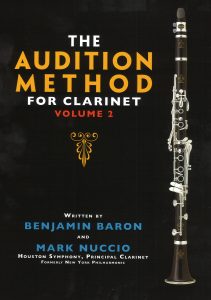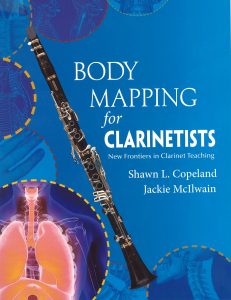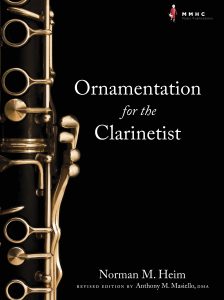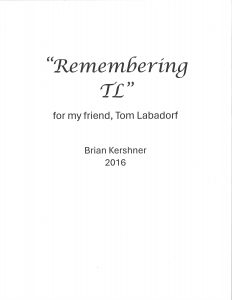
Originally published in The Clarinet 51/4 (September 2024).
Copies of The Clarinet are available for ICA members.
Book and Music Reviews:
September 2024
BOOKS
 Gino Ascoli. Lo Chalumeau, il Clarinetto e il Corno di Bassetto nel Concerto, nella Sinfonia Concertante e in alter composizioni con funzione solistica. Un contributo al repertorio fino al 1899. Bibliografia commentate. (The Chalumeau, the Clarinet and the Basset Horn Included in the Concertos, Sinfonia Concertante and in other Solo Compositions. A Catalog of the Repertory up to 1899. An Annotated Bibliography.) Four volumes, self-published in Italian, 2024. $80 for four volumes. Amazon.com.
Gino Ascoli. Lo Chalumeau, il Clarinetto e il Corno di Bassetto nel Concerto, nella Sinfonia Concertante e in alter composizioni con funzione solistica. Un contributo al repertorio fino al 1899. Bibliografia commentate. (The Chalumeau, the Clarinet and the Basset Horn Included in the Concertos, Sinfonia Concertante and in other Solo Compositions. A Catalog of the Repertory up to 1899. An Annotated Bibliography.) Four volumes, self-published in Italian, 2024. $80 for four volumes. Amazon.com.
Gino Ascoli is an Italian amateur clarinet player and enthusiast who has been able, over some decades, to put together an incredible amount of information and data regarding compositions written for chalumeau, clarinet, and basset horn with a soloistic or leading role. The chosen criteria in this collection are quite specific, which excludes a long list of some of the well-known and celebrated compositions of Mozart, Brahms, Schumann, and Weber to cite a few, giving predominance to the rare, unknown, and neglected clarinet repertory. The musical forms taken into consideration are the concerto, double concerto, and the sinfonia concertante (also called concertone or double concerto, etc). All these compositions are listed in alphabetical order by composer and use large fonts for easy reading. The compositions listed number approximately 3500, necessitating four thick volumes. All the compositions have bibliographical references and list the libraries, archives, and private collections where the manuscripts or printed editions are preserved. In some cases, Ascoli adds a comment to offer precious information to some compositions of particular interest. In the last volume an extensive and most interesting discography is present, considering both performers and composers.
Gino Ascoli did an incredible job of such a large size that I would define it as a “one of a kind” project. Of course, we should cite the clarinet bibliography of H. Haas, which is without a doubt the most comprehensive book regarding the clarinet repertoire, embracing all possible instrumental combinations. Ascoli’s books are however unique in the criteria of chosen soloistic and rare clarinet repertoire. Despite the Italian language used in the long preface or in some comments (not all the pieces listed have comments), the endless list of compositions cited in these four volumes is very easy to consult and to understand for any musician, professional, or amateur clarinet player of any nationality. We should congratulate Mr. Ascoli for his indefatigable job of compiling these four big volumes on sale at a very reasonable price. Highly recommended!
– Luigi Magistrelli
 Benjamin Baron and Mark Nuccio. The Audition Method for Clarinet, Volume 2. Chicago: GIA Publications, 2023. $48.95. GIAmusic.com.
Benjamin Baron and Mark Nuccio. The Audition Method for Clarinet, Volume 2. Chicago: GIA Publications, 2023. $48.95. GIAmusic.com.
David Shifrin writes in the foreword to The Audition Method for Clarinet, Volume 2, “Playing in an orchestra is not the only career path for clarinetists but is certainly the most frequently sought-after goal of students and young professional clarinetists.” That is undoubtedly true, and yet there are notably few resources on the market designed to aid in the pursuit. The Audition Method by Benjamin Baron and Mark Nuccio aims to fill the gap, offering a systematic approach to the standard audition repertoire and to the audition process itself. Now in its second volume, it collects, demystifies, and puts onto the printed page many of the concepts and tricks of the trade that already circulate through the collective consciousness of orchestral playing, but that are too rarely documented.
Each excerpt is presented in three versions: the original as found in orchestra libraries and audition packets, an “annotated” version meticulously marked up with performance suggestions and cues, and an “audition” version that distills those suggestions down to a common practice interpretation. Throughout the book, a succinct set of markings is employed, some familiar and some novel. Blue ink is used to clearly differentiate editorial markings from those that originated with the composer. Also included are a fingering chart and practice planner.
Volume 1 came out 10 years ago and covered 22 excerpts. Volume 2 adds 18 more, including the second movement of Mozart’s Concerto,Kodaly’s Dances of Galanta, Mendelssohn’s Symphony No. 3, “E lucevan le stelle” from Puccini’s Tosca, Rimsky-Korsakov’s Scheherazade, the infamous “Variation” from Stravinsky’s Firebird, and Tchaikovsky’s Symphony No. 6. Galanta and Firebird are especially welcome and enlightening additions. Between the two volumes, most of the truly unavoidable excerpts have now been treated, and The Audition Method begins to rival Peter Hadcock’s posthumously-published classic The Working Clarinetist for breadth.
Conceptually, The Audition Method is written from the standpoint of “how best to distinguish yourself from others when playing alone on stage.” The answer, as you might expect, is through exhaustive preparation, a faithful and clear rendering of the required material, and a healthy measure of individual artistry. These books are a welcome toolkit for audition candidates and teachers alike, from authors who have experienced auditions on both sides of the curtain. They are a lasting contribution to our literature, destined, as Burt Hara puts it in his endorsement, to “appear on every clarinet student’s stand.”
– Daniel Friberg
 Shawn L. Copeland and Jackie McIlwain. Body Mapping for Clarinetists: New Frontiers in Clarinet Teaching. Chicago: GIA Publications, 2024. $35.95. GIA
Shawn L. Copeland and Jackie McIlwain. Body Mapping for Clarinetists: New Frontiers in Clarinet Teaching. Chicago: GIA Publications, 2024. $35.95. GIA
music.com.
Shawn L. Copeland and Jackie McIlwain are two of the leading experts on Body Mapping, a method of increasing physical self-awareness to prevent/eliminate performance-related injuries. Copeland previously served as associate professor of clarinet at the University of Idaho and McIlwain is associate professor of clarinet at the University of Southern Mississippi. They came to Body Mapping through personal experience and intensive study of Alexander Technique, the well-known method for observing and changing bodily habits to reduce/eliminate tension to move with greater freedom. Copeland had numerous eye disorders that necessitated 18 months of therapy and countless clarinet lessons. McIlwain suffered from a nerve compression injury that mandated four months off playing the clarinet and relearning old habits. Their collaboration has culminated in a comprehensive book, Body Mapping for Clarinetists: New Frontiers in Clarinet Teaching.
According to the authors, “Body Mapping is a way to intentionally clarify, refine, and change one’s body map to better align with reality so that movement is freer and less restricted.” The book is organized into six detailed sections. In the introductory section, the authors recount their personal experiences and give the historical background on Alexander Technique and its relationship to Body Mapping. The second section, “Attention,” addresses mental and physical awareness and the differences between sensation and perception, and between awareness and attention. The third section, “Body Mapping: Mapping Balance,” details the various parts of the body and their functions and concludes with the mechanics of holding the clarinet. In the fourth section, “Mapping the Structures and Movement of Breathing,” the authors stress that it is not just breath support that is important but rather breathing efficiency. The fifth section, “Body Mapping and Playing the Clarinet,” covers the pedagogical mechanics of embouchure, tongue position and movement, voicing, air compression, articulation, and resonance. The final section, “Mapping the Whole Self,” ties all the above subjects together and addresses performance psychology.
Body Mapping for Clarinetists not only covers all the above subjects in depth; it serves as a pedagogical guide to both teachers and students of the clarinet. The book contains helpful diagrams of the various parts of the body and regular “experiences” in which the reader is guided through practical activities that implement the topics discussed. Body Mapping for Clarinetists is very well written and has spiral binding so that it can be opened flat like a workbook. Because of its workbook format and excellent organization, it can be read at one’s own pace and held open while implementing the practical experiences. There is no index, but the table of contents is extremely detailed. The authors write with welcome candor about their own unfortunate experience with performance injuries and various health conditions and how they both came to surmount their difficulties through greater self-awareness. This is one of the most important books on Body Mapping since the 1998 publication of Barbara Conable’s What Every Musician Needs to Know about the Body: The Practical Application of Body Mapping to Making Music. Every clarinetist will be better off after reading Body Mapping for Clarinetists. Every musician will be better off after reading it as well. I certainly am myself.
– Rebecca Rischin
 Norman M. Heim, revised edition by Anthony Masiello. Ornamentation for the Clarinetist. MMHC Music Publications, 2024. Ebook and hard copy $19.95. AZ
Norman M. Heim, revised edition by Anthony Masiello. Ornamentation for the Clarinetist. MMHC Music Publications, 2024. Ebook and hard copy $19.95. AZ
musicmasters.com.
This newly updated version of Norman Heim’s 1993 edition, undertaken by Anthony Masiello, is meant to provide guidelines for ornamentation in works dating mainly from before 1800. Masiello’s principal contribution to a new edition has been to update the appearance of the examples; he also adds some new material in the spirit of Heim’s original examples. Their intention is certainly good, with the basis focusing mainly on the manner in which to perform ornaments provided by the composers in works from the Classical era. In 1993, it is reasonable to assume that relatively little Baroque music for the clarinet was known and/or performed, and indeed Heim notes that “the repertoire is limited in that era.” Things have changed. More than 300 works for chalumeau are now available, as well as nearly 100 pieces calling for clarinet, pre-1760. In any case, judging from the music discussed in the book, Heim feels most comfortable in the Classical period with composers like Carl Stamitz and Xavier Lefèvre, which is reflected in the majority of examples. A small concern is that the author conflates primary sources such as C.P.E. Bach and J.J. Quantz with later writers like Betty Bang Mather and Edward Dannreuther. Although the latter derive their contributions from period sources, they should probably not be taken to have equal authority.
The earliest methods for the clarinet date from the late 18th century, and ornamentation is peripherally discussed. Examples are usually limited to the trill, turn (gruppetto) and appoggiatura (grace note). To these, Heim quite reasonably adds the slide and the mordent. And although the sources for repertoire under discussion are mainly modern editions, reference is also made to IMSLP, which Heim would not have had access to. The editions referred to are recent, and while several are quite good, many are not. This is similarly true with what is available on IMSLP. Many of the great masterworks, such as those by Mozart and Beethoven, are available in truly lamentable versions online. One must use caution and whenever possible check against manuscript sources and first editions. Luckily more and more of these are also available online.
The first few examples are by composers such as Corelli, Loeillet, J.S. Bach, Handel, and Tartini, before we get to anything originally composed for the clarinet. These examples mainly deal with starting trills from the upper note. The limits of what can be notated prevent demonstration of an improvised character in execution, which in several sources recommend a small acceleration in the trill before the resolution. In examples with a dotted rhythm, Heim feels free to alter the penultimate note by either shortening (so-called “double-dotting”) or lengthening. These indeed add to a sense of improvisation. Trills are by far the most common ornament in music before 1800, and having an organic feeling as to how to execute them is worth cultivating. One point often not included by Heim is, for lack of a better word, “Nachschlag.” Quantz perhaps puts it best when he notes that although the Nachschlag is not strictly necessary, all the best players add the two quick notes at the end of a trill. Moving on to the appoggiatura, in the Molter Concerto No. 3 example, Heim correctly interprets this ornament as taking half the value of the note it precedes—this rule, stated in all 18th-century sources, needs to be taken on board by all players, who tend to play any and all appoggiaturas as quickly as possible. The point with these examples, and indeed with all 18th-century music, is to favor dissonance and minimize consonance. This requires both an understanding and a sense of taste that corresponds with the era. Our notion of what sounds “right” today in many ways does not correspond to what we know about interpretation in music from 200 years ago.
On the same subject, often the notated appoggiatura consists of a small eighth note with a line through it, and these are indeed meant to be played quickly if decorating a dissonance (sometimes called acciaccatura). They provide an accent and communicate a sense of energy and vigor. Timing is everything in these examples, and sadly it is the most difficult aspect to communicate in a book. One commends this effort and especially the window it will open for players today. The present author has spent his entire life as part of the “Early Music” movement, and what’s become known as HIP, or Historically Informed Performance. The interface between historical instruments and music of the era, while utilizing performance practice principles taken from period sources, can lead to a satisfying result. The lovely Telemann Double Concerto in D Minor performed on chalumeaux with Baroque strings and harpsichord takes one to another world, which cannot be, nor should it be, possible on modern equivalents. Ornamentation and some improvisation enhances the music immeasurably; this is the spirit in which Norman Heim compiled his book, and it is certainly to be commended.
– Eric Hoeprich
 Christopher D. Jones. Bumblebee Loops: A Practice Guide to Performing a Lightning Fast “Flight of the Bumblebee” for violin, flute, or clarinet. CreateSpace Independent Publishing Platform, 2017. Paperback: $9.99. Clarinet-now.com.
Christopher D. Jones. Bumblebee Loops: A Practice Guide to Performing a Lightning Fast “Flight of the Bumblebee” for violin, flute, or clarinet. CreateSpace Independent Publishing Platform, 2017. Paperback: $9.99. Clarinet-now.com.
Christopher D. Jones, a 25-year clarinetist with the West Point Band and the author of clarinet-now.com, presents an array of chromatic drills and exercises with the goal of achieving seamless technique and great musicality. Short progressive excerpts of Rimsky-Korsakov’s Flight of the Bumblebee are used to build skills towards an effortless technical performance of this exciting and challenging solo.
This book can be used by young students at the beginning of their study through professional players, and appropriate range options are offered. Jones gives suggestions to encourage players to consider technical practice in a musical and efficient way. The end goal of the book is to build slow, healthy practice habits.
This book only covers two key signatures: A minor and B minor, as per the different versions of Flight of the Bumblebee available. Players can select the key to the version of solo they wish to perform. The book offers range options for the octave appropriate to ability and experience.
The first exercise is a very simple chromatic eighth-note study covering the middle chalumeau register. The author recommends use of our under-utilized left-hand sliver key DÏ and the side FÏ for technical ease. The author suggests looping all exercises to hone and polish 4 bars or 8 bars at a time. The reader can choose to work on the upper octave, lower octave or both, pending ability and experience.
Throughout the book, the author gives encouraging quotes by great musicians, philosophers, poets, athletes and more. One notable quote by Helen Keller is appropriate to this book: “We can do anything we want to if we stick to it long enough.” If utilized in the way the author intends, through slow, steady repetition with a focus on phrasing, ease of facility, and persistence, the player will easily conquer the Bumblebee.
Once players have worked through all exercises, practice secrets and tips are offered to achieve a “Lightning-Fast Bumblebee”—anyone of any level can achieve effortless speed if they follow the practice strategies outlined. Jones gives excellent suggestions on fundamental awareness, articulation, how to utilize the metronome to build speed, and how to work towards goal tempos.
Bumblebee Loops is a fun chromatic technical method and guide to help players of all levels “get on top of the instrument” and master their technical practice.
– Julianne Kirk Doyle
MUSIC
 Karen Amrhein. Event Horizon for clarinet and chamber orchestra. Happy Lemon Publishing. 2002. Score and parts $10. KarenAmrhein.com.
Karen Amrhein. Event Horizon for clarinet and chamber orchestra. Happy Lemon Publishing. 2002. Score and parts $10. KarenAmrhein.com.
Karen Amrhein (1970) is an award-winning composer and two-time Pulitzer Award nominee. Her evocative piece Event Horizon is a welcome addition to the clarinet repertoire for solo instrument with orchestra. Based on William J. Kaufmann’s book Black Holes and Warped Spacetime, the piece is a fanciful marriage of science and music. Amrhein refers to Kauffman’s book as an “armchair excursion through some of the most mysterious and magnificent phenomena in the universe.” She masterfully pairs many of the elements in Kaufmann’s book with the soaring range and timbral possibilities of the clarinet.
Originally a single movement work, Amrhein later added two more to great effect. The piece begins with “Prelude”; a soaring melody on clarinet accompanied by strings and marimba. The movement continues to explore mixed rhythms and a delightful interplay between the soloist and orchestra. The second movement, “Night,” is rhapsodic yet driving, encapsulating the relationship between humans and the cosmos. With an almost innocent love for melody, Amrhein is stirring yet also reflective, giving the clarinet free rein in a stunning cadenza that allows the instrument to yearn and sing.
“Event Horizon,” the final movement, is all-encompassing, tracing the climactic death of a star to the formation of a black hole. Taking us through different iterations of this process, Amrhein’s music allows us to glimpse the mysteries of space through her deft and effective writing. The final movement is a tour de force, taking the listener through the different stages of this phenomenon. These states include musical explorations on the aspects of a black hole: Implosion, Electron Dance, Vortex, Descent, Singularity, Einstein-Rosen Bridge, Through the Wormhole, The Other Side, and The Realm of Earth and Air. Amrhein is able to match her literary acumen with her poetic and well-considered compositional style.
Event Horizon is the perfect blend of stimulating yet also enjoyable music. While virtuosic at times, Amrhein’s work is also approachable and idiomatic for the clarinet. The length of the piece is reasonable for a modern audience and would fit nicely on most orchestra seasons.
– Stephanie Zelnick
 Robert S. Cohen. Strange and Wondrous Adventures in Space for clarinet quintet (EÌ, three BÌ clarinets, bass). Leapfrog Productions, 2023. $34.95. RobertSCohen.com.
Robert S. Cohen. Strange and Wondrous Adventures in Space for clarinet quintet (EÌ, three BÌ clarinets, bass). Leapfrog Productions, 2023. $34.95. RobertSCohen.com.
Robert S. Cohen is a prolific composer who has written music for chorus, orchestra, chamber ensemble, dance, and theater and has received numerous awards. He also co-authored the book and composed the score for the award-winning Richard Rodgers off-Broadway musical Suburb, published by Dramatic Publishing. He is also treasurer and board member of the New York Composers Circle. He has a BA in music from Brown University where he studied with composer Ron Nelson and an MA in music from Queens College, and was in the doctoral program at Columbia University.
Strange and Wondrous Adventures in Space was specifically composed for the Namaste Quintet, a unique ensemble that utilizes all the instruments of the clarinet family. The group is known for its innovative approach, constantly researching new musical arrangements and commissioning new music for the ensemble. It frequently collaborates with contemporary composers for world premiere compositions, adding a fresh and dynamic element to the group’s repertoire.
Movement 1, “Surfing the Event Horizon,” is a maze of chromatic scale passages, texturally intertwining between all five parts. There is constant motion, and the trick will be to make all these lines connect to sound like one long chromatic passage. You better know your chromatic scale to play this one! The second movement, “Talosian Love (or It Ate My Heart)” is a welcome change from the constant chromaticism. The melodic material is a lovely duo in the first and second clarinet, while the lower voices provide a lovely polyphonic textural support. The third movement, “Dodging Gamma Rays,” is the first movement where I can feel the “space adventure.” It is static and chaotic, but also exciting to listen to. The final movement, “Sailing Over the Pillars of Creation,” is slow and lyrical at first, a nice contrast from the prior movement. The texture thickens as the movement proceeds, and the voices are polyrhythmic. As the movement closes, the texture thins, as do the dynamics, leaving the final four measures with just two voices, softly diminishing to a hushed conclusion.
I like this piece very much. It is exciting and appealing, and it contains a diversity of sounds and intricate rhythms that make it electrifying and challenging. Technically, the piece is quite advanced, so a professional ensemble or a good college ensemble could perform it.
– Lori Ardovino


Antonio Fraioli. Mr. Contrabass Clarinet for solo contrabass clarinet in BÌ or EÌ. VigorMusic, 2023. $13. www.vigormusic.it.
Antonio Fraioli. September in Kraków for woodwind quintet. VigorMusic, 2023. $24. Vigormusic.it.
Antonio Fraioli is an Italian clarinetist and composer whose performances and compositions are often heard at ClarinetFests®. His most recent compositions include this work for solo contrabass clarinet and a woodwind quintet. Mr. Contrabass Clarinet is a short work that would make an excellent recital piece for a low clarinet specialist, or for an advanced high school or collegiate student. The work is based on a clearly stated twelve-tone row, repeated in different rhythms three times at its start. The row is then treated more freely throughout most of the rest of the work but is stated very clearly at its conclusion.
The work does call for the extended range contra, which would imply it would be more specifically intended for the BÌ instrument rather the EÌ. It does not use many extended techniques, but it does incorporate flutter-tonguing, frullato, and slap-tonguing. Any performer will need a supple tonguing technique as there are numerous repeated notes, although the tempo is marked as moderato, which could be interpreted as “at a comfortable speed for this articulation.” The dynamics range from pp to fff. The tessitura is a full three octaves, from the extended low C to high clarion C. However, the work does not venture into the altissimo register, and uses no microtones or multiphonics.
Fraioili’s other work is his woodwind quintet September in Kraków. He describes the work as “a jazz inspired ballad, conceived for the sounds of a classic wind quintet.” Most of the parts do not appear to be difficult, both rhythmically and otherwise. Its use of primarily duple rhythms makes this a simple piece to put together. The only triplets are in the clarinet part, which does seem to be the most challenging individual part in the group. Even that part is not particularly difficult. The piece could be played by a high school group, providing that the clarinetist up to it. (Fraioli seems to have wanted to make this a bit of a clarinet feature.) The phrasing fits into the composer’s idea of a “ballad.” It falls rather neatly into regular eight-bar phrases, with only a few four-bar transitional phrases in the intros, coda, and interludes. Highly recommended for young players.
– Timothy Bonenfant
 Brian Kershner. Remembering TL for BÌ clarinet and piano. BrikerMusic, 2016. $12. Trevcomusic.com.
Brian Kershner. Remembering TL for BÌ clarinet and piano. BrikerMusic, 2016. $12. Trevcomusic.com.
Dedicated by the composer to his friend, clarinetist Tom Labadorf, Remembering TL exudes the sorrow and sense of loss following Tom’s untimely death. From Kershner’s program note, the piece integrates “…references to works he and I performed together, as well as some other very well-known works for his instrument.” These references within the piece are subtle and reworked, acting more as source material than as recognizable quotations within the piece. Perhaps because of its unified character, this work feels shorter than its seven-minute playing time might indicate, making it a good choice to place in a program as a contrast between longer, more ebullient works.
Fittingly for the subject and its dedication, the piece is pensive and slow, maintaining its somber character throughout. There are notable moments (including the beginning) that feature the piano by itself, establishing it as an equal voice in the duo and contributing to the sense of space and emptiness that pervades the work. The clarinet lines are facile and free with a lyrical sense of flow that contributes to a timeless, meditative feeling. There are intermittent moments of quick, sometimes loud playing that, nonetheless, lead back to environmental, spare piano parts, just as the occasional metrical sections resolve to music that holds the space of longer rests and rubato sensitivity. As the piece unfolds, one gets a sense of the breadth of experiences shared between Tom and the composer. And much like the life of this piece’s dedicatee, the piece seems to end sooner than one might have expected, with an unresolved quality that prompts one to imagine the trajectory that could have been. This haunting and poignant sensation, prepared by the music preceding it, seems to capture the feelings surrounding loss in a way that is both subtle and recognizable to anyone who has experienced similar emotions.
Effective and powerful in an understated way, Remembering TL is a beautiful remembrance that could be just the right fit for a concert needing a thoughtful piece to give texture and depth to a program.
– Gregory Oakes
Comments are closed.